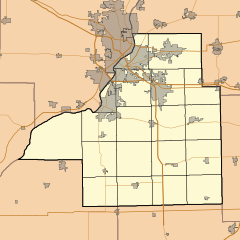Pekin Federal Building facts for kids
Quick facts for kids |
|
|
Old Post Office
|
|

View from east, 2011
|
|
| Location | 334 Elizabeth St. Pekin, Illinois |
|---|---|
| Area | 0.4 acres (0.16 ha) |
| Built | 1906 |
| Built by | V. Jobst & Sons, of Peoria |
| Architect | James Knox Taylor |
| Addition architect | J.A. Wetmore |
| NRHP reference No. | 80001412 |
| Added to NRHP | October 9, 1980 |
The Old Post Office, also known as the Pekin Federal Building, is a historic building in Pekin, Illinois. It was built in 1906. This building used to hold many important U.S. government offices for Pekin.
The first floor was the city's main post office. The second floor had other offices. These included a Treasury Department office and an Army recruitment office.
Contents
Building Design and Style
The Old Post Office was designed by James Knox Taylor. He was the Supervising Architect at the time. He designed the building in the Renaissance Revival style. This style was often used for government buildings. It made them look grand and important.
Key Architectural Features
The building has a red brick outside. It sits on a limestone base. You can see special stone blocks called quoins on the corners. The windows on the first floor have decorative fanlights and keystones above them. A limestone cornice (a decorative molding) runs along the top. There's also a parapet wall (a low protective wall) and a cartouche (a fancy carved design) above the main entrance.
History of the Building
The Post Office stayed in this building for many years. It served the people of Pekin.
Changes Over Time
In 1966, the Post Office moved to a new location. The building was then sold to private owners in 1967. Because of its history, the building was added to the National Register of Historic Places on October 9, 1980. This means it's recognized as a very important historic site.
Current Use and Upkeep
Later, the building was bought by the Tazewell County government. County board meetings were held there for a while. Today, several county offices still work out of the building.
In 2016, a large crack appeared on the east side of the building's addition. This happened because that part of the building settled unevenly. Since the building is historic, the county quickly asked for help to fix and support the east side.


